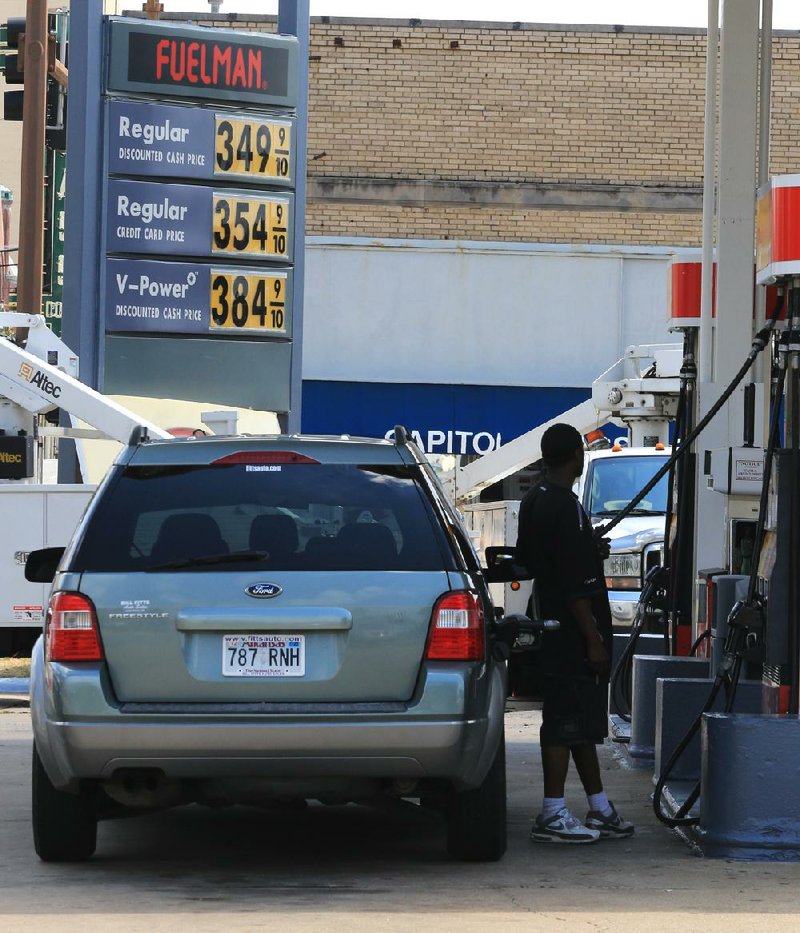LITTLE ROCK — Gasoline prices have jumped about 30 cents since last month as the cost of crude oil rose amid speculation about governmental stimulus programs and Middle East political tensions.
On Monday, the average U.S. price of regular gasoline was $3.70 per gallon. At $3.48 per gallon, the average Arkansas price for regular was the same as it was a year ago, said Mike Right, spokesman for auto club AAA.
Arkansas average prices ranged from $3.46 in the Little Rock and Texarkana metropolitan areas to nearly $3.51 in the Fayetteville-Springdale-Rogers area.
At this time last month, the U.S. average was $3.39 per gallon, and in Arkansas it was $3.19, Right said.
Arkansans saw a 9-cent increase in the price of gas since last week, when prices averaged $3.39. The U.S. average last week was $3.61.
“We saw one of the biggest spikes in gasoline prices, at least since April, when we saw the high of the year,” said Phil Flynn, senior energy analyst for PFG Best, a brokerage firm.
Diesel prices also have been rising, although at $3.82 per gallon in Arkansas, the fuel is selling for about a nickel less than its price a year ago, according to AAA.
“Anytime the economic forecast improves, the price of crude oil will normally rise,” Right said.
Analysts attribute the rise in fuel prices to apprehension over conflicts in the Middle East and expectations of improved economic activity. The higher prices aren’t expected to last into the fall, when demand tapers off.
Internationally, there have been several problems that have driven up crude oil prices, including a lower supply of Brent crude from the North Sea because of maintenance work there, Flynn said.
There have also been several geopolitical issues - including the new U.S. sanctions against Iran and the continued dispute over Iranian nuclear facilities, he said.
“Whenever that heats up, the cost of crude goes up as well,” Flynn said.
While Syria’s ongoing civil war continues to produce more uncertainty for the region - especially because of its proximity to Iraq - it isn’t affecting oil prices, said James Williams, an energy analyst and owner of the consulting firm WTRG Economics near Russellville.
“Syria just makes you nervous,” he said. “The Syrian state is a non-event. The reality of it is that Syria’s exports are negligible so it really doesn’t impact the market.”
Williams said, that crude oil has increased by about $12 per barrel since June.
The benchmark U.S. crude oil fell 14 cents to $92.73 a barrel Monday in New York Mercantile Exchange trading, and wholesale gasoline fell 1.3 cents to end at $2.99 per gallon.
In April, when prices peaked, crude oil averaged about $105 a barrel in New York trading.
Brent crude oil, which is used to price international oil, rose 65 cents to $113.60 per barrel in London.
“Our worldwide inventories of crude oil are in good shape,” Williams said. “There seems to be plenty of supplies, so a lot of it is fear of what could happen, than what the current situation is, so that tends to move up the market.”
Also factor driving oil prices up is the possibility of further governmental economic stimulus. The European Central Bank is expected to reduce key borrowing rates for Spain and Italy to help battle Europe’s debt crisis, while some analysts think the U.S Federal Reserve will take further stimulus action next month.
“A lot is going to depend on what happens with the global central banks,” Flynn said. “A big part of the rally we have seen with the cost of oil is anticipation of seeing stimulus.”
Although nothing has been decided yet, the world’s central banks recently have said they are prepared for further stimulus programs, he said.
“The price of crude would go up at least initially because when the government does stimulus, then the money goes down and commodities go up,” he said.
Flynn said if further stimulus doesn’t happen, then the cost of crude will fall because of fear of the effects that would have on struggling Europe.
Right, of AAA, said that recent U.S. refinery problems also pushed up gasoline prices by curtailing distribution.
“Anytime there is a restriction in the supply or distribution, generally the price of gas will go up nationally,” he said.
The “cluster of refinery events” weren’t major except for a fire at Chevron’s Richmond refinery near San Francisco last week, said Tom Kloza, chief oil analyst for Oil Price Information Service, a source for petroleum pricing and news information.
The Associated Press reported that the fire happened when a vapor cloud ignited and produced a large blaze.
The refinery normally produces about 16 percent of California’s daily gasoline supply.
Other refinery problems in the Midwest involved small reductions in production, Kloza said.
The upturn in gas prices is not expected to have much longevity.
Kloza said prices will be a little high for the rest of the month and will slowly fall the rest of the year.
“Gasoline prices are drifting higher, but after Labor day, demand drops and import increases,” he said. “I don’t think we are going to approach the high of the year or the highs we saw in 2008 or 2011.”
Front Section, Pages 1 on 08/14/2012

